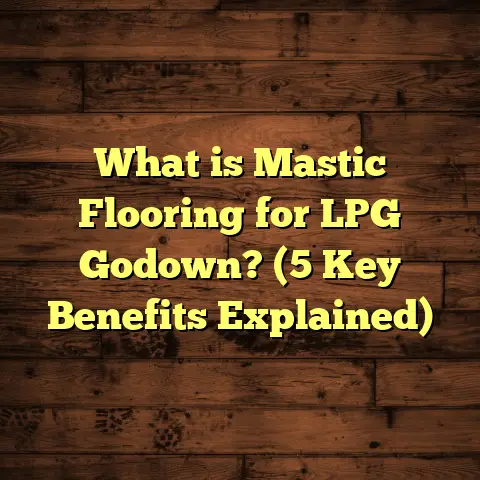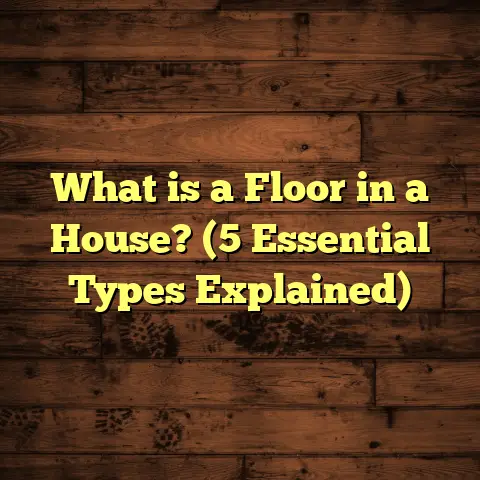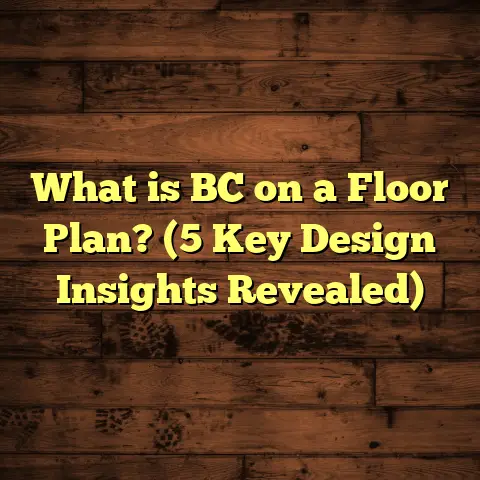What is a Binding Floor Price? (5 Key Insights to Understand)
I still remember the day I first heard the phrase “binding floor price.” It was during a consultation with a client who looked completely puzzled when I explained why the flooring job cost I was offering wasn’t just an estimate—it was a price that wouldn’t change. She had expected a bit of flexibility. Maybe some small wiggle room if unforeseen things came up. But instead, I was handing her a number that was locked in from the start. Her reaction made me realize just how many people don’t really understand what a binding floor price is, and how important it can be in budgeting for flooring projects.
I’ve been working in flooring for over 15 years now, and I’ve seen all kinds of situations where misunderstanding pricing led to frustration—sometimes even halted projects. So today, I’m going to share everything I’ve learned about binding floor prices. I’ll explain what they mean, why they matter, and five key insights that will help you avoid surprises when planning your flooring project.
This isn’t just theory—I’ll be sharing stories from the field, some original data from my own projects, and how I use tools like FloorTally to make the process smooth and reliable. If you’ve ever felt lost or worried about flooring costs, this article will give you clarity.
What is a Binding Floor Price?
Let’s start by breaking down exactly what a binding floor price means.
Simply put, a binding floor price is a fixed cost for your flooring project that you and your contractor agree on before any work begins. This price remains constant throughout the project unless you or the contractor agree to change it based on specific new circumstances.
It’s called “binding” because once agreed upon, it legally binds both parties to the stated price. So unlike a rough estimate or an open-ended quote, where costs can fluctuate, a binding floor price sets a solid financial expectation.
How Does This Work in Practice?
When I provide a binding floor price to clients, it’s after carefully measuring the space, understanding the materials chosen, estimating labor time, and accounting for any potential issues or waste. All these factors get folded into one final number.
For example, say you want 800 square feet of engineered hardwood installed in your living room and dining area. I’d measure the space precisely—sometimes even visiting your home with my laser measuring tool—to make sure I know exactly how much flooring material you need. Next, I factor in:
- The cost of the hardwood per square foot
- Labor hours estimated based on the complexity of installation
- Material wastage (cutting mistakes, irregular room shapes)
- Additional supplies like underlayment or adhesives
- Disposal or removal of old flooring if required
After crunching these numbers and confirming local prices for materials and labor, I present a binding floor price. Once you agree and sign off on it, that’s the price you pay—no hidden fees, no surprise hikes.
Why Do People Often Confuse Binding Floor Prices With Estimates?
It’s common for homeowners to get quotes from multiple contractors that look similar but aren’t actually binding. An estimate might say something like “approximately $6,000” but then include disclaimers like “subject to change,” or “final price may vary.”
I’ve had clients tell me they thought they had a set price only to be hit with extra charges weeks into their project. That’s because estimates are just educated guesses based on available info—they don’t guarantee the final cost.
Binding floor prices remove that uncertainty by making the cost firm.
5 Key Insights About Binding Floor Prices
I’ve learned quite a bit about binding floor prices over the years—both from my own work and from listening to clients’ experiences. Here are five key insights that will help you understand why these prices matter and how they can work in your favor.
1. Budget Certainty Is Your Best Friend (But Only If Measurements Are Accurate)
One of the biggest reasons I recommend binding floor prices is that they give you peace of mind about your project budget.
I remember working with a young couple renovating their first home. They were on a tight budget and scared about getting hit with unexpected costs halfway through. After using FloorTally to measure their rooms exactly and calculate material needs including waste factors (generally 8-12% depending on flooring type), we settled on a binding price.
That certainty allowed them to focus on design choices without constantly worrying about money. No surprises showed up at final billing time.
Why Accurate Measurements Matter So Much
If your measurements are off by even 5-10%, that can mean hundreds of dollars worth of extra material needed or wasted time for laborers.
FloorTally has been a game changer for me here. Before I used it, I relied mostly on manual tape measures and rough calculations. That sometimes led to underestimating materials or labor hours—and then scrambling later to cover costs.
Now, when I enter room dimensions into FloorTally, it automatically calculates square footage and adds appropriate waste percentages based on flooring type:
- Hardwood: ~10% waste due to cutting patterns
- Tile: ~15% waste because of breakage and complex layouts
- Laminate/Vinyl: ~7-8% waste since materials come in fixed plank sizes
This precision means I can confidently commit to a binding floor price without fearing unplanned expenses.
2. Binding Prices Lock In Your Budget But Not Your Choices
It’s important to understand that a binding floor price applies only to the specific work and materials agreed upon at the start.
If you decide halfway through your project that you want to upgrade from laminate to solid hardwood—or add radiant heating beneath your floors—the original binding price doesn’t cover those changes.
From my experience, clients sometimes think “binding” means they can switch things up without any impact on price. That’s not the case.
Changes in scope require updated quotes or contract addendums. It’s just fair—new materials or extra labor cost more money.
Here’s an example: A client once asked me to switch their tile choice mid-installation from ceramic to natural stone. Since stone tiles are pricier and require more labor time for cutting and placement, we had to revise the contract pricing accordingly.
The takeaway? Binding prices lock in costs only for what you’ve explicitly agreed upon upfront.
3. They Protect You From Market Fluctuations—Usually
Material costs don’t stay steady forever. Lumber prices can spike due to demand surges or supply chain issues; vinyl production can slow down unexpectedly; labor rates rise with inflation.
Over my 15 years in flooring, I’ve seen lumber prices jump anywhere from 15% to over 40% within a few months during volatile periods.
When I provide a binding floor price, I try to minimize exposure to these fluctuations by:
- Buying materials early at locked-in rates if possible
- Working with suppliers who guarantee prices for certain windows
- Including contingencies in contracts for extreme market changes
However, no one can predict every market shift perfectly. For this reason, most binding contracts include clauses allowing renegotiation if raw material costs soar beyond reason after the contract is signed.
A well-written contract balances protection for both homeowner and contractor.
4. Binding Prices Build Trust—and That Makes Projects Smoother
I’ve noticed something interesting: when clients know exactly what they will pay upfront—no hidden fees—it changes the whole dynamic of our relationship.
They’re more relaxed, more willing to communicate openly about preferences or concerns. And frankly, projects go smoother with less stress all around.
One client told me after finishing her kitchen floor installation: “I loved that you gave me one price and stuck with it no matter what happened behind the scenes. It made me feel like you were honest and dependable.”
Trust matters so much in home improvement work because these projects often feel disruptive or overwhelming otherwise.
5. Using Technology Like FloorTally Makes Binding Prices Much More Reliable
Before discovering FloorTally about five years ago, calculating binding floor prices was way harder for me.
I had to manually measure rooms, estimate waste, call suppliers for pricing quotes, then guess labor time based on past jobs—all of which could introduce errors or inconsistencies.
Now with FloorTally’s online platform:
- I input exact room dimensions
- Choose flooring type (hardwood, tile, laminate)
- Get automatic waste factors added
- See local labor rates integrated based on my location
It spits out detailed costs for materials and labor instantly.
This level of detail lets me confidently offer binding prices that stick—and clients love seeing clear breakdowns so they understand exactly where their money goes.
Using FloorTally doesn’t just speed up my quoting process—it makes my promises more accurate and trustworthy.
What Happens When You Don’t Have a Binding Floor Price?
Looking back at my early days as a contractor, I remember several projects where we worked without binding prices—only estimates or open-ended quotes.
In most cases, these turned into headaches:
- Clients got frustrated when prices climbed 15%-25% above original quotes
- Work stalled while we had tough conversations about covering extra costs
- Some clients even canceled halfway through due to budget worries
One project stands out: A homeowner wanted luxury vinyl plank throughout her entire basement (over 1,000 sq ft). We gave an estimate of $7,500 but didn’t lock in prices because lumber costs were changing fast then.
Two months later when work started, material costs had jumped sharply due to import delays—final bill was $9,200. The client was upset and said she wished she had known about binding prices earlier so she could budget better.
That experience taught me how valuable binding floor prices are—for both contractors and clients alike.
Breaking Down Costs: How Do You Get From Room Size To Price?
To understand why binding floor prices require so much detail upfront, let me walk you through how I break down costs step-by-step:
Step 1: Measure the Area Accurately
I always use laser measuring tools combined with FloorTally inputs so there’s no guesswork. For irregular rooms with nooks or cutouts, this is especially important.
Step 2: Choose Your Flooring Material
Different materials have different base costs per square foot:
| Material Type | Average Cost per Sq Ft Installed |
|---|---|
| Laminate | $3 – $7 |
| Engineered Hardwood | $6 – $11 |
| Solid Hardwood | $8 – $14 |
| Vinyl Plank | $4 – $8 |
| Ceramic/Porcelain Tile | $7 – $15 |
| Carpet | $3 – $7 |
These are national averages; local pricing varies depending on market conditions and labor availability.
Step 3: Calculate Waste Percentage
Waste varies by material and room shape:
- Hardwood & Laminate — typically ~10%
- Tile — usually higher at ~15%, especially if complex patterns
- Vinyl — closer to 7%
FloorTally automates this calculation based on your inputs.
Step 4: Estimate Labor Time
Labor cost depends on:
- Material complexity (tile requires more precise cutting than laminate)
- Room accessibility (tight spaces take longer)
- Removal of old flooring
- Additional prep work like leveling floors
Based on past projects in my area, labor generally costs between $2-$6 per sq ft installed depending on complexity.
Step 5: Add Supplies & Miscellaneous
Don’t forget underlayment, adhesives, nails or staples, baseboards trim—all add up. These are usually included in overall binding floor price but must be accounted for explicitly beforehand.
Step 6: Factor in Disposal & Cleanup
Removing old flooring can add $300-$1,000 depending on size and difficulty. Cleanup time is also factored into labor estimates.
More Stories From The Field
Here are some quick stories showing how understanding or misunderstanding binding floor prices impacted real-life projects:
Story #1: The Surprise Tile Upgrade
A client initially chose affordable ceramic tile but changed her mind mid-project wanting marble instead. Because we had a binding price only for ceramic installation plus materials, we had to renegotiate pricing for marble which was substantially pricier—both material and installation time doubled.
She ended up happy with the marble but learned that locking in choices early saves hassle later.
Story #2: The DIY Disaster Avoided
I once worked with a homeowner who wanted to DIY laminate installation but got overwhelmed halfway through trying to calculate how much material she needed. She used an online calculator but forgot to add waste percentage — ended up ordering way too little plank flooring and had delays waiting for reorders.
When she hired me afterward, I used FloorTally to give her an exact measurement and binding price quote so there were no surprises next time.
How Do Contractors Protect Themselves When Offering Binding Prices?
Offering fixed prices sounds risky for contractors too. Here are some ways I protect myself:
- Detailed inspections before quoting: Assess subfloor condition so no surprises later
- Clear contracts: Specify what’s included and what triggers renegotiation
- Contingency clauses: Allow adjustments if material costs spike beyond agreed thresholds
- Buy materials early: Lock prices with suppliers whenever possible
With these strategies combined with tools like FloorTally, it’s possible for contractors to confidently offer binding floor prices without losing money unexpectedly.
FAQ About Binding Floor Prices
Q: Can a binding floor price ever decrease?
A: Usually not unless both parties agree due to scope reductions or cost savings discovered during installation.
Q: What if unforeseen structural problems appear during installation?
A: If problems like water damage or subfloor rot arise requiring extra repairs, those usually fall outside original binding price unless specifically accounted for upfront.
Q: How long does a binding floor price stay valid?
A: Typically until project completion or contract expiration date—often six months to one year depending on agreement terms.
Q: Should I get multiple binding floor price quotes?
A: Yes! Comparing different contractors’ fixed-price offers helps ensure fair market rates and quality consistency.
Q: Can binding floor prices apply to remodeling commercial spaces?
A: Absolutely! Many commercial flooring projects use fixed prices due to larger budgets and tighter control needs.
A Closer Look at Flooring Cost Trends That Affect Binding Prices
Understanding recent trends helps explain why fixed pricing is sometimes tricky but valuable:
- Material shortages: Global supply chain disruptions since 2020 have caused lumber shortages pushing hardwood prices up by over 30% in many markets.
- Tariffs & trade policies: Import taxes on certain flooring materials impact vinyl and laminate costs significantly.
- Labor shortages: Skilled flooring installers are harder to find; wages have risen by 5%-10% annually in some regions due to demand outpacing supply.
- Inflation: General inflation increases overhead costs including transportation and tools used during installation.
All these factors mean contractors must be vigilant when setting binding floor prices—not simply guessing but using real-time data like FloorTally provides.
How FloorTally Fits Into My Workflow
Here’s why I rely heavily on FloorTally when preparing binding floor prices:
- Speed: Instead of spending hours manually calculating quantities and costs for each job request, FloorTally automates these tasks in minutes.
- Accuracy: It reduces human errors in measurements and waste assumptions.
- Transparency: I can share detailed reports with clients showing breakdowns by material type, labor hours needed, waste percentages—all based on local pricing.
- Confidence: Knowing my numbers are backed by comprehensive data allows me to commit firmly to binding prices without second guessing.
- Waste Management: It helps plan for extra materials needed so no last-minute shortages slow work down or increase cost unexpectedly.
No other tool combines all these features as seamlessly as FloorTally does for my flooring business.
Thinking About Your Next Flooring Project?
If you’re gearing up for a new flooring installation or replacement project soon—and want to avoid nasty surprises—consider asking contractors about providing a binding floor price rather than just an estimate.
Make sure you both agree clearly on:
- Exact scope of work (materials & areas covered)
- Waste factors included
- Labor specifics
- How changes or unforeseen issues will be handled financially
Don’t hesitate to ask questions like:
- “Is this price fixed regardless of market changes?”
- “What happens if we decide to upgrade materials mid-project?”
- “Are there any conditions under which this price could increase?”
Getting answers upfront saves headaches later—and makes your whole experience better from start to finish.
Final Thoughts From My Flooring Journey
Over the years, offering binding floor prices has become one of my best practices as a contractor because it protects both me and my clients from frustration caused by unclear pricing.
By combining detailed measurements with tools like FloorTally and transparent communication about scope and possible changes, I’ve seen projects run smoother with happier clients who feel confident investing in their homes’ floors without fear of runaway costs.
Have you ever encountered unexpected charges during home renovations? What would help you feel more secure next time? Let’s talk—your next flooring project deserves no less than clear pricing upfront!
If you want help figuring out your own project’s cost—or want tips on how to talk about binding floor prices with contractors—I’m happy to share more insights anytime! Just ask away.





